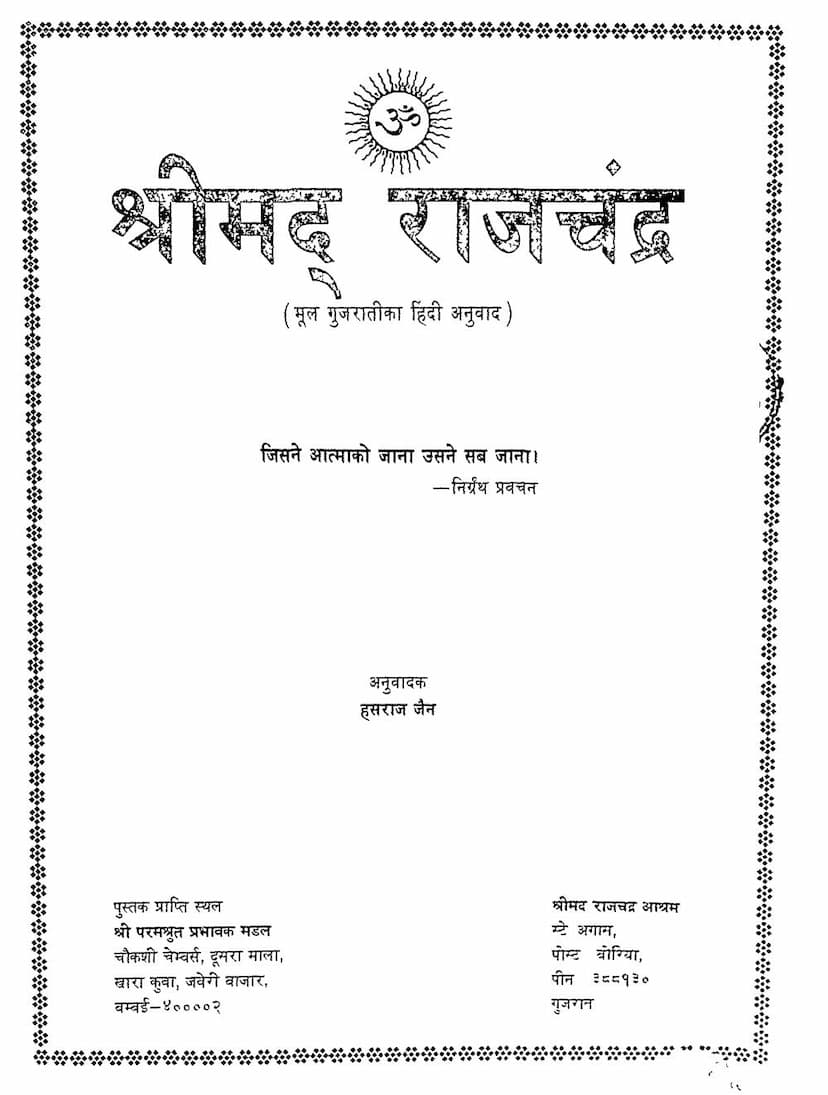Shrimad Rajchandra
Added to library: September 2, 2025

Summary
Based on the provided text, here is a comprehensive summary of the Jain text "Shrimad Rajchandra" by Hansraj Jain, published by Shrimad Rajchandra Ashram:
Overview:
"Shrimad Rajchandra" is a collection of spiritual and philosophical teachings attributed to Shrimad Rajchandra, a revered Jain spiritual leader and contemporary of Mahatma Gandhi. The book, translated from Gujarati to Hindi by Hansraj Jain, aims to guide individuals towards self-realization and spiritual liberation, central themes in Jainism. The text comprises various sections, including philosophical verses, devotional poems, dialogues, and instructive advice, all stemming from Rajchandra's profound spiritual insights and experiences.
Key Themes and Teachings:
The book delves into several core Jain principles and spiritual practices, emphasizing the path to liberation (Moksha) through self-knowledge and detachment. Key themes include:
- Self-Knowledge (Atma Vichar): The paramount importance of knowing one's true self, the soul (Atma), is repeatedly stressed. The text asserts that understanding the soul is understanding everything. It encourages introspection and the realization of the soul's inherent purity, consciousness, and bliss, distinct from the physical body and worldly affairs.
- Detachment (Vairagya): A significant portion of the text focuses on cultivating detachment from worldly possessions, relationships, and sensory pleasures. It advocates for recognizing the impermanence of all material things and the transient nature of worldly happiness, encouraging the pursuit of eternal spiritual bliss.
- Right Faith and Conduct (Sammyak Darshan and Charitra): The book highlights the necessity of right faith, which involves understanding the true nature of reality as expounded by the Tirthankaras. Right conduct, characterized by ethical living, non-violence (Ahimsa), truthfulness (Satya), non-possession (Aparigraha), and chastity (Brahmacharya), is presented as the path to spiritual progress.
- The Role of the Guru: The text emphasizes the indispensable role of a true Guru (Sadhguru) in guiding the seeker towards self-realization. A Guru, enlightened by true knowledge and living in detachment, is depicted as the ultimate source of spiritual wisdom and liberation.
- Conquering the Mind and Senses: The teachings stress the importance of controlling the mind and senses, which are seen as the primary obstacles to spiritual progress. Through practices like meditation, introspection, and detachment, the mind can be disciplined to turn inward towards the soul.
- The Nature of Reality: The text explores the Jain perspective on the nature of reality, distinguishing between the soul (Atma) as the true self and the soul's manifestations in various forms of existence, as well as the non-soul (pudgala) and its illusory nature. It elucidates concepts like karma, its bondage, and its eventual liberation.
- Renunciation and Asceticism: While acknowledging the path for householders, the text often points towards the ultimate goal of renunciation and asceticism as the most direct route to liberation, aligning with the Jain ideal of monks and nuns.
- Living in the World, Yet Detached: The teachings also provide guidance for householders, emphasizing how to live in the world while cultivating detachment from its allurements and fulfilling one's duties with equanimity.
- The Impermanence of Life: The text repeatedly reminds readers of the fleeting nature of life, health, wealth, and relationships, urging them to utilize their present human birth wisely for spiritual pursuits.
- The Path to Moksha: The ultimate aim is liberation from the cycle of birth and death (Samsara). This is achieved through self-realization, the eradication of karma, and the attainment of the soul's pure, omniscient, and omniscient nature.
Structure and Content:
The book is presented as a compilation of Shrimad Rajchandra's profound thoughts, often expressed in a poetic and aphoristic style. The content is drawn from his writings, letters, and recorded discourses. The text includes numerous quotes and verses that encapsulate his spiritual wisdom, often referenced by "Aak" (Verse) numbers, suggesting a structured collection of his sayings.
Publisher's Note and Translator's Contribution:
The publisher's note highlights the journey of this book, from its original Gujarati text to various Hindi translations. It acknowledges the efforts of previous translators and the meticulous work involved in bringing out this particular edition, emphasizing the commitment to providing accurate and accessible spiritual literature to the Hindi-speaking community. The translator, Hansraj Jain, is recognized for his contribution in making these profound teachings available.
Overall Message:
Shrimad Rajchandra's teachings, as presented in this book, are a call to spiritual awakening. They advocate for a life of self-discipline, introspection, and unwavering devotion to the soul's true nature. The ultimate message is one of profound peace, liberation, and the realization of the soul's inherent divinity, achievable through diligent spiritual practice and the guidance of a true Guru.